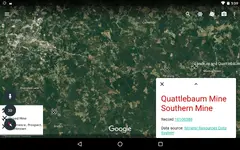The Original poster's map shows the general locations of some mines. This
MRDS (Mineral Resources Data System) information is from the USGS and focused on commercially viable/actual deposits. The MRDS shows actual mines and workings and contains some data on actual observations of the workings. I think the original poster already knows that since they referred to the history of mining and the actual mines displayed on their map.
The USGS MRDS does not have geochemistry or mineral potential but other programs (NURE, PLUTO, NGCDB and several other specialized programs) do have some of those features. There are many geologic databases as well as mineral potential and geologic maps of particular areas available from the USGS. None of that is the subject of the original posters question.
To answer the original posters question... Gold travels as far downstream as it can before being trapped in a riffle, clay body or low pressure zone. Generally gold is the last mineral to move and the one least susceptible to being broken down into smaller pieces. That makes gold pretty darn slow moving. Gold of any quantity will almost always be found near it's source.
Gold does not usually form "nuggets". Most gold is deposited and eroded from the rock in small particles. The size and shape of the gold particle have as much to do with how far it travels as does the incidence of flood or landslide.
So the answer is "it depends but not very far". The idea that all gold eventually travels to the sea is only true over time spans much greater than humans have been on earth. You could set up at the mouth of any river and wait for the gold to arrive but if you were to sample most current river's mouths you will find out rather quickly that is not a productive way to prospect.
Gold is where you find it but assuming gold will always travel further downstream is not an assumption that will pay off in any quantity of actual gold. Try panning the mud of San Francisco Bay where all the Motherlode rivers drain to and you won't find gold worth panning.
Heavy Pans







